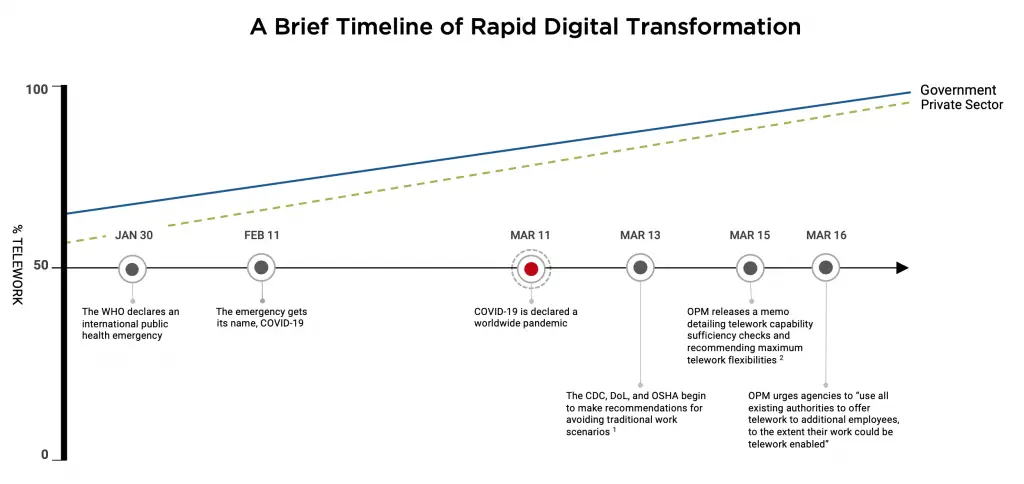Crisis has a way of forcing innovation, testing readiness, and laying a foundation for “new norms.” At the time when the COVID-19 outbreak officially entered the United States in late January 2020, more than 43% of working-age individuals categorized themselves as ‘remote’ employees, 56% of businesses reported being “hybrid” organizations with telework options available, and 64% of government agencies were doing the same.
Those telework numbers soared to almost 100% in a matter of hours, and it has put our country’s presumed readiness for telework to the test.

1 https://www.osha.gov/SLTC/covid-19/
2 https://fcw.com/articles/2020/03/15/coronavirus-telework-flexibility.aspx
Agencies, including the Social Security Administration, the State Department, the Department of Defense, and the Department of Education, all have communicated revised or emergency telework policies. For these agencies, and many others, as well as companies around the nation, this rapid workforce transition required a few checks — things like making sure employees had access to the necessary hardware and connectivity (laptop, phone, wifi), security protocols were understood and enacted (VPN), remote meeting platforms and schedules were in place, and working parents had a plan.
For most, the abrupt mandates have constituted a VERY real-time test of preparedness. Despite the fact that government agencies have recognized the utility of telework since the 2001 Transportation and Related Agencies Appropriations Act, some leaders are reporting feeling unprepared for the reality of keeping the government working.
In Washington D.C. alone, telework measures are impacting 250,000 federal workers and thousands more on-site contractors.
Even the baseline considerations for success, technology, collaboration, and workspaces considerations are more challenging than expected. For government agencies, the abrupt transition to telework is challenging for a host of reasons. Securing high amounts of personally identifiable information (PII) and meeting government-mandated security standards are two. Another is the cultural shift necessary to move away from reliance on manual and paper-based processes to trusting technology at a higher level.
What’s required for telework at scale
The rapid outbreak and spread of a pandemic have put the actual state of digital transformation to the test for many organizations. For mandated teleworking for employees and contractors to become a permanent and scalable norm, agencies need to do more than master the fundamentals of digital collaboration platforms.
It’s not coincidental that NT Concepts very recently published an article detailing an iterative approach to digital transformation on the heels of a deep look at the triggers that signal a need for Robotic Process Automation (RPA) and the processes for its successful implementation. As a leading National Security solution provider, we work with the agility of a startup and the stability of a GovCon veteran, and we use that balance to help our agency partners do the same. Not only do we have successful and stable telework infrastructure in place for our employees and contractors, we also have guided numerous agencies through thoughtful, structured steps to instituting telework policies, resources, and procedures. In response to program needs and space constraints, NT Concepts has successfully transitioned hundreds of employees from in-house to telework in a low technology, labor-driven work environment.
What we all lack now is a long runway for an incremental digital transformation. What we can do, however, is follow a set of best practices built over the two decades since the Transportation and Related Agencies Appropriations Act. With a well-planned approach, it is possible to institute telework policies that quickly position employees and contractors to succeed with remote work without creating risk to the network, data, or processes.
Considering the COVID-19 crisis, we are providing insights gained from implementing and leading a large-scale distributed workforce, including how to prepare your organization for a successful rapid workforce deployment.
Best practices for rapid telework platform implementation
The following recommendations come from years of experience working with agencies to design, implement, and measure digital transformation efforts. It is a three-pillared approach that considers processes, technologies, and policies designed to position the organization and its people to succeed with remote work without creating risk to the network, data, or processes. Some of these steps are already underway—others should be considerations your team is making as quickly as possible during this time.
A Establish Your Process
Before rolling out the telework platforms and environments, establish and document a detailed process for implementation that includes:
- A clear communication plan that covers who, what, when, where, why, and how communication happens
- Access to and understanding of all platforms including collaboration systems (e.g., Microsoft Teams), telecoms, phone, and text
- Accurate contact information for employees, leadership, help desk, and HR
- Training processes
- Security protocols
- Requirements and expectations by function
- How workload will be assigned and monitored by function
- How process and policy changes will be communicated and trained, if needed
- Hardware distribution and collection protocol
- User support channels, including an internal help desk, training resources, and hardware malfunction protocols
B Build Your Technology Landscape
Having the appropriate resources in place, and ensuring that everyone is able to use them to their fullest potential is absolutely critical. At minimum, we recommend that any organization instituting telework procedures must:
- Understand customer hardware, software, and system requirements
- Maintain at least a minimum hardware inventory to begin implementation within 10 business days
- Maintain repair/replacement inventory
- Maintain current and robust inventory management documentation
C Solidify Your Internal Policy
With all the platforms in place, have a policy in place internally and get it approved by clients in writing. The policy should include:
- Eligibility, both functionally and based on individual performance and tenure
- What the company is providing or covering vs employee’s responsibility (e.g., extra monitors, a stipend for the cost of internet)
- Requirements related to connectivity, security, access, PII management and more
- Expectations related to working hours, schedules, and performance standards
- The auditing process (e.g., home visits and system audits)
- Contact information and availability requirements
Before anyone signs the agreement, make sure they understand the requirements and expectations. Carefully note the differences between on-site work and telework, outlining expectations related to daily considerations like break time, extended hours, and communications with team members and managers. Clarify that there is no commitment to continued telework, noting that in normal scenarios, it is a privilege that is dependent on workloads, hardware and system availability, customer needs, and policies. And once underway, be sure to review and update the policies annually, by client and by function.
For those organizations able to transform the traditional working environment to one where telework is more the norm, the long-term economic and efficiency benefits can be nearly as significant as flattening the COVID-19 curve. Once the urgency of the situation has subsided, evaluate the challenges and successes, and consider the incredible, measurable savings that digital transformation and telework can have on overtime, hard costs, space requirements and how it can continue to fuel innovation and leadership for your organization.
